Summary
Understand the role of banking and financial services in India's growth. This blog covers the structural story and its implications for investors. This blog provides in-depth analysis and practical advice. These funds are suitable for long-term investors looking to save on taxes. They offer a unique combination of tax savings and potential for high returns over time.
Let me start this with an interesting question...
When was the first-ever loan given? Any guesses?
If you are done with your guesses, continue reading!
Okay, time for a confession. No one knows exactly when this happened. According to historical records currently accessible, the first loans are estimated to have been sanctioned at least 3,700 years ago.
Here is an excerpt of lending guidelines from the Babylonian text ‘Code of Hammurabi’ which was inscribed back in the 18th Century BCE.
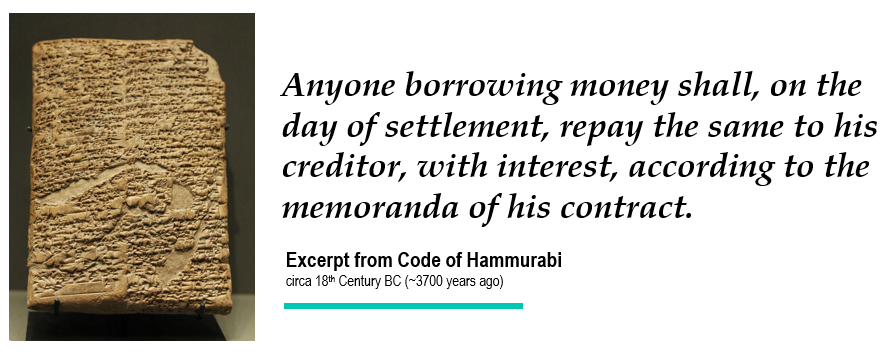
Source: Cornell University Library, Louvre, Archive.org
And back home, Arthashastra (written almost 2200 years ago) notes the usage of a cheque-like instrument named ‘Adesa’ during the Maurya period.
So clearly, banking and financial services have been around for thousands of years.
While several other sectors and themes have come and gone, the Banking and Financial Services (BFSI) sector has been and continues to be The Structural Story.
To get a glimpse of this structural story, let us look at how the Banking and Financial Services sector has fared in the last two decades...
In the last 15-20 years, the BFSI sector has gone through troubled times led by the Global Financial Crisis (Lehman Bros & Bear Stearns shut down), European Debt Crisis, Taper Tantrum, Demonetization, NPA crisis, NBFC Crisis, Banking troubles in India (GTB, Yes Bank, LVB, etc.,) and the West (Credit Suisse, SVB, etc.).
To put it mildly, things haven’t been easy for the BFSI sector!
But what if I tell you that despite these ‘bad’ events, the Banking & Financial Services sector has grown faster than the economy?
Between FY08 and FY23, India’s nominal GDP grew at an annualized rate of 12.1%. In the same period, the different subsegments of the banking & financial services grew at a faster (or at least similar) pace.
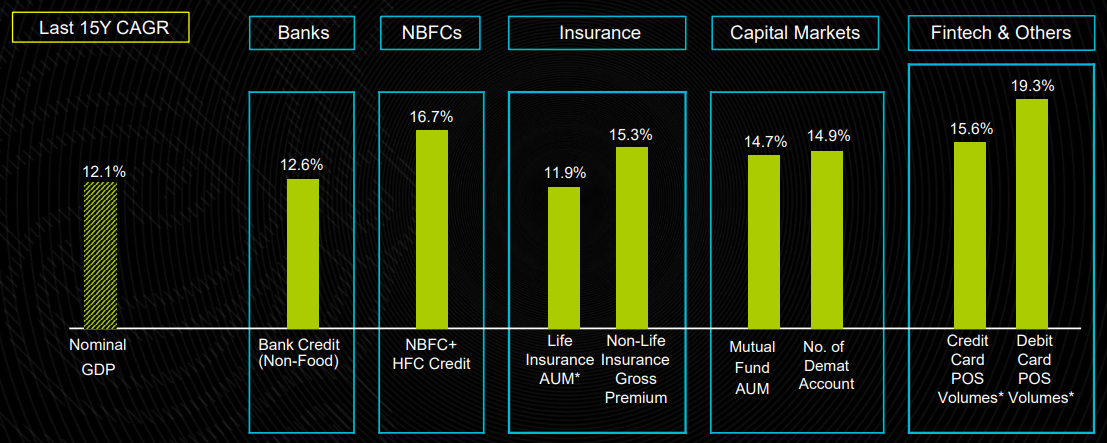
Source: CMIE, Kotak Securities, IRDAI, Investec, CDSL, NSDL. 15Y CAGR for the period FY08 to FY23. *Life Insurance AUM and Card POS Volume CAGR is for the period FY12 to FY23. BFSI – Banking, Financial Services & Insurance. CAGR – Compound Annual Growth Rate. NBFCs – Non-Banking Financial Companies. HFC – Housing Finance Companies. POS – Point of Sale. AUM – Assets Under Management
Okay, but the returns surely must have taken a hit?
Not really.
Despite challenges, the Nifty Financial Services TRI (which can be taken as a proxy for the BFSI sector) delivered a CAGR of 17.6% between Jan-04 and Sep-23 versus 14.0% for Nifty 50 TRI.
The money invested in the Nifty Financial Services index in Jan-04 multiplied over 24 times in 19-odd years!
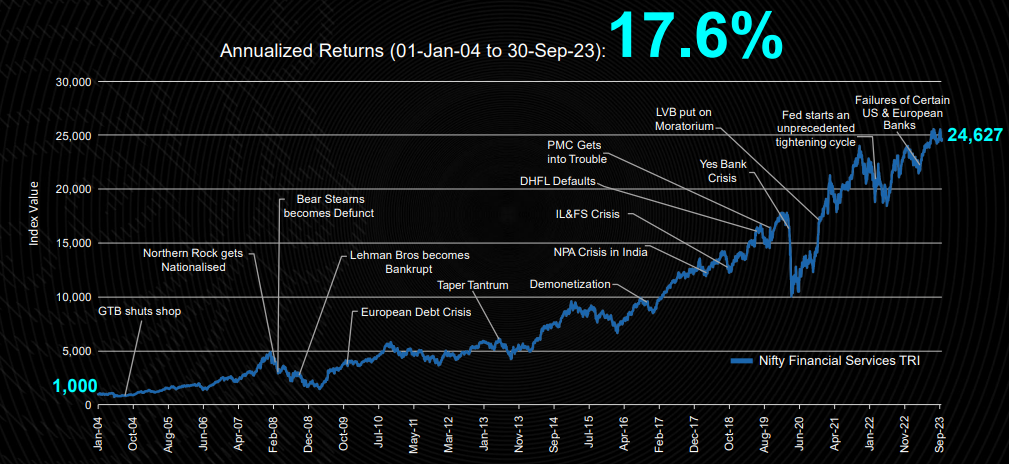
Source: Internal. Index Values from MFI Explorer. Data for the period 01 Jan 2004 to 30 Sep 2023. BFSI – Banking, Financial Services & Insurance. Nifty Financial Services Index is taken as a proxy for BFSI sector. Past performance may or may not be sustained in future and should not be used as a basis for comparison with other investments. These figures pertain to performance of the index/model and do not in any manner indicate the returns/performance of this scheme.
And the BFSI returns historically have been better and more consistent compared to the broader Nifty 50 index across periods.
Nifty Financial Services TRI has outperformed Nifty 50 TRI on all 10-year periods since 2004. And nine out of ten times, the Nifty Financial Services TRI has delivered annualized returns greater than 12% over a 7+ year timeframe (vs 52% for Nifty 50 TRI).

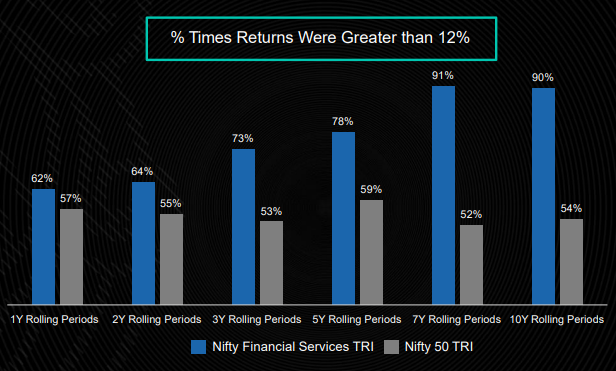
Source: Internal. Index Values from MFI Explorer. Data for the period 01 Jan 2004 to 30 Sep 2023. BFSI – Banking, Financial Services & Insurance. Nifty Financial Services Index is taken as a proxy for BFSI sector. Past performance may or may not be sustained in future and should not be used as a basis for comparison with other investments. These figures pertain to performance of the index/model and do not in any manner indicate the returns/performance of this scheme. There is no assurance of any returns/capital protection/capital guarantee to the investors in the Scheme. The Scheme being sectoral in nature carries higher risks versus diversified equity mutual funds, thus one should take controlled exposure to such funds.
Now that the structural story is clear, let us look at the current set-up of the Indian BFSI sector...
While Banking & Financial Services is thematic in nature, it comprises of multiple subsegments including Banks, NBFC, Life and Non-life Insurance, Asset Management Companies, Exchanges, Depositories and Credit Rating Agencies which make it very diversified.
A snapshot of the BFSI subsegments can be seen below:
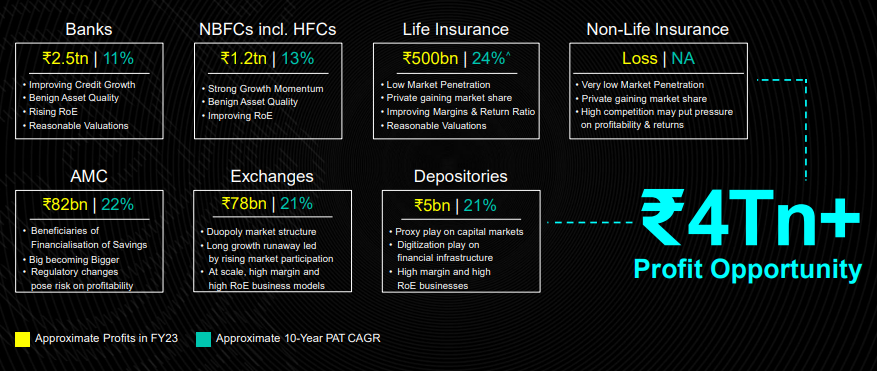
Source: RBI, Kotak Securities, Morgan Stanley Estimates, Investec, Spark Capital Research, Internal. Note: ^Value of New Business CAGR for the period FY18- 23 is shown for life insurance (listed private players only). Non-life Insurance data excludes reinsurance. NBFCs – Non-Banking Financial Companies. HFC – Housing Finance Companies. AMC – Asset Management Companies. RoE – Return on Equity. CAGR – Compound Annual Growth Rate. The sector(s)/stock(s)/issuer(s) mentioned in this document do not constitute any recommendation of the same and the Fund may or may not have any future position in these sector(s)/stock(s)/issuer(s).
Put together, all the sub segments amounted to a whopping Rs. 4 lakh crore profit pool in FY23!
However, the BFSI space is still under-penetrated.
Despite its strong structural growth over the years, the Indian BFSI sector remains under-penetrated when compared to other major economies.
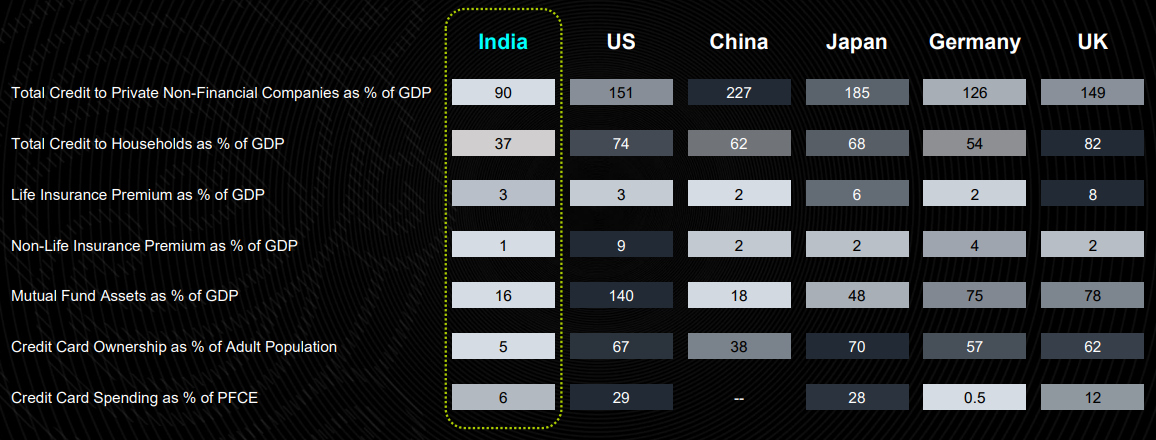
Source: World Bank, BIS, Swiss Re Sigma World insurance report No 3 /2023, Kotak Securities, Internal. Total Credit to Households as % of GDP and Total Credit to Private Non-Financial Companies as % of GDP data are as of Q1 CY23. Life/Non-Life Insurance Premium to GDP is as of 2022. MF Assets to GDP is as of 2020. Credit Card penetration data are as of 2021. Adult population considers people aged 15 and above. Credit Card Spending as % of PFCE data for China is not available. PFCE – Private Final Consumption Expenditure.
This lower penetration across segments promises a strong growth runway for the future.
So, should you consider investing in the Banking & Financial Services sector?
You might have already guessed our answer.
But let me give you three key reasons as to why now seems to be a really good time to invest in the Banking and Financial Services sector.
1. Sharp underperformance in the last four years indicates the possibility of a turnaround
The BFSI sector has seen a sharp underperformance compared to the broader index. Nifty Financial Services TRI has underperformed Nifty 50 TRI by 4% CAGR since Sep-19. This underperformance on a 4-year rolling basis is closer to the underperformance levels last seen during the Global Financial Crisis in 2008.
Historically such phases where the Nifty Financial Services index underperformed the Nifty 50 index on a 4-year rolling basis have been good entry points to invest in BFSI.
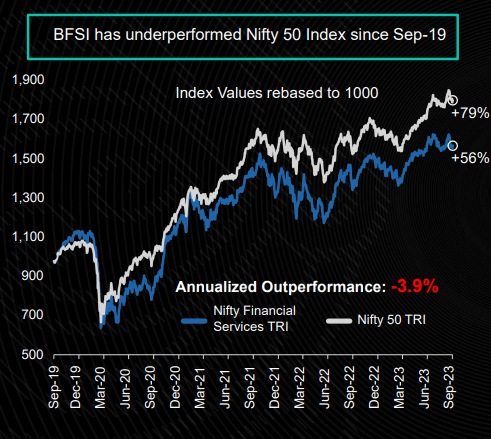
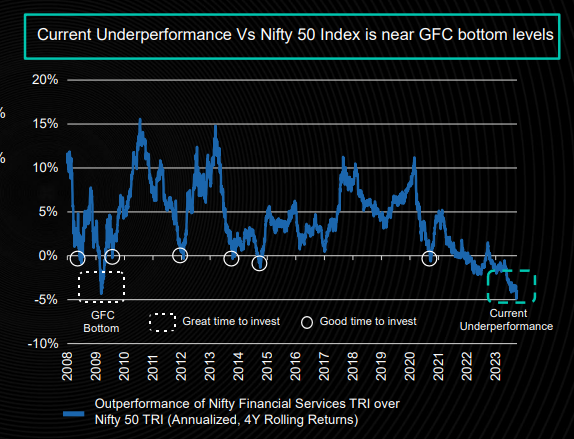
Source: Internal. Index Values from MFI Explorer. Data for the period 01 Jan 2004 to 30 Sep 2023. BFSI – Banking, Financial Services & Insurance. GFC – Global Financial Crisis. Past performance may or may not be sustained in future and should not be used as a basis for comparison with other investments. These figures pertain to performance of the index/Model and do not in any manner indicate the returns/performance of this scheme.
2. Reasonable valuations
The BFSI sector currently trades at valuations closer to historical averages – offering a reasonable entry point.
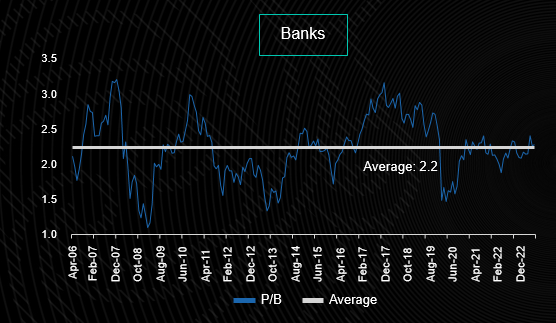
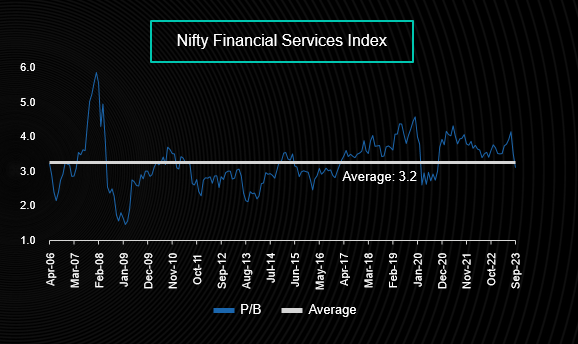
Source: Kotak Securities, NSE, Internal. P/B – Price to Book Value. The sector(s)/stock(s)/issuer(s) mentioned in this document do not constitute any recommendation of the same and the Fund may or may not have any future position in these sector(s)/stock(s)/issuer(s).
3. Strong balance sheets and profitability
Bank balance sheets are currently strong with non-performing loans close to all-time low levels. This could help with a sustained pick-up in credit growth.

Source: RBI, Kotak Securities, Morgan Stanley, Internal. Data as of 31 Mar 2023. NPA – Non Performing Assets. Note: NPA data is only for banks. The sector(s)/stock(s)/issuer(s) mentioned in this document do not constitute any recommendation of the same and the Fund may or may not have any future position in these sector(s)/stock(s)/issuer(s).
Plus, the profitability of the BFSI sector has also been quite strong with the return ratios at decent to high levels.

Source: RBI, Kotak Securities, Morgan Stanley, Internal. Data as of 31 Mar 2023. BFSI – Banking, Financial Services & Insurance. ^For life insurance, Return on Embedded Value is taken and the number shown considers only private sector listed players (public sector listed insurer’s RoEV data is not available). The sector(s)/stock(s)/issuer(s) mentioned in this document do not constitute any recommendation of the same and the Fund may or may not have any future position in these sector(s)/stock(s)/issuer(s).
Summing it up...
The Structural Story
Banking and financial services sector has been around for thousands of years and continues to be a strong growth story
Despite facing multiple challenges in the last two decades, the BFSI sector has largely outpaced the economy and delivered a CAGR of ~17%. Currently, the profit pool is over Rs 4 lakh crore spread across diversified subsegments
Still Underpenetrated
Indian BFSI sector remains under-penetrated when compared to other major economies and offers growth potential
3 Reasons to Invest in BFSI Sector Now
Sharp underperformance in the last four years versus the broader Nifty 50 index - Possibility of a reversal
Reasonable valuations
Strong balance sheets and profitability
Conclusion
With a legacy spanning a millennia and a dynamic present characterized by resilience and potential, the BFSI sector in India continues to be a compelling narrative of growth and evolution. Its ability to weather storms, coupled with a promising future marked by underexplored growth avenues, positions the sector as a cornerstone of the country's economic narrative. Embracing its historical significance and understanding its current dynamics, investors can discern the promising prospects that lie within the ever-evolving landscape of Indian banking and financial services.
Industry insights you wouldn't want to miss out on.
Written by
Disclaimer
All content on this blog is the intellectual property of DSPAMC. The user of this site may download materials, data etc. displayed on the site for non-commercial or personal use only. Usage of or reference to the content of this page requires proper credit and citation, including linking back to the original post. Unauthorized copying or reproducing content without attribution may result in legal action. The user undertakes to comply and be bound by all applicable laws and statutory requirements in India.
In this material DSP Asset Managers Pvt. Ltd. (the AMC) has used information that is publicly available, including information developed in-house. Information gathered and used in this material is believed to be from reliable sources. While utmost care has been exercised while preparing this document, the AMC nor any person connected does not warrant the completeness or accuracy of the information and disclaims all liabilities, losses and damages arising out of the use of this information. The recipient(s) before acting on any information herein should make his/their own investigation and seek appropriate professional advice. The statements contained herein may include statements of future expectations and other forward looking statements that are based on prevailing market conditions / various other factors and involve known and unknown risks and uncertainties that could cause actual results, performance or events to differ materially from those expressed or implied in such statements. The sector(s)/stock(s)/issuer(s) mentioned in this presentation do not constitute any research report/recommendation of the same and the schemes of DSP mutual fund may or may not have any future position in these sector(s)/stock(s)/issuer(s). All opinions/ figures/ charts/ graphs are as on date of publishing (or as at mentioned date) and are subject to change without notice. Any logos used may be trademarks™ or registered® trademarks of their respective holders, our usage does not imply any affiliation with or endorsement by them. These figures pertain to performance of the index/Model and do not in any manner indicate the returns/performance of the Scheme. It is not possible to invest directly in an index.All data source is Internal unless specifically mentioned, and is up to Jul 31, 2023
Past performance may or may not be sustained in future and should not be used as a basis for comparison with other investments.
 Account Statement
Account Statement  Capital Gain Statement
Capital Gain Statement  Key Information Memorandum
Key Information Memorandum  PAN Updation
PAN Updation  Register / Modify KYC Online
Register / Modify KYC Online  Nominee Registration
Nominee Registration  Email / Phone Updation
Email / Phone Updation  OTM / eNACH Registration
OTM / eNACH Registration  Guidelines for Incapacitated Investors
Guidelines for Incapacitated Investors  FAQs
FAQs Reach us
Reach us



















Comments
Total 22
Arif Ahmed
23-09-2024
Mind enlightening write up. Share your universal knowledge on the subject for learning financial management of common people.
Moyukh Roy Choudhury
23-09-2024
Excellent read on discipline approach of investing and patience for long term wealth creation .
Dr.Haresh V. Mavadia
23-09-2024
Excellent
Yogesh Laddha
23-09-2024
Thanks for Sharing this Article, It's the real situation of all investors......
Jitu Pran Das
23-09-2024
Guarantee 👍
Saroj Kumar behuria
24-09-2024
Nice topic
Bhanu
24-09-2024
Beautifully penned down. Touches the right chord with the investors
Vikram Shah
24-09-2024
Great Article!
Chandra Bhushan Singh
24-09-2024
Yes patient is the key for equity investment. I remember the opportunity which I missed in 2008 Lehman Brother Crisis, The nav of DSP Tax saver was Rs 5 but now it is 80 i.e. whatever invented that time would have been converted to 16 times today. That is righ moment this blog is talking about.
Pradeep
24-09-2024
This is very interesting & a very lucid way to carry the story forward without making it a text book reading. Thanks for presenting this story to us.
Saroj behuria
25-09-2024
It's very encouraging.
Deborshi Bhattacharjee
25-09-2024
Your writing is so powerful, you put into words exactly what I struggle to convey.
Karnalsingh Bajaj
25-09-2024
Very correct, very authentic, true to life. Money is not every thing. Values of life count too.
MUSADDIQUE HUSSAIN
25-09-2024
Thank you for making me aware of such an important issue. I appreciate your insights.
Partha Sarathi Chandra
25-09-2024
It’s really encouraging
RAFIQUDDIN AHMED
25-09-2024
Very informative
Reny Gomes
25-09-2024
I didn't know something like LRS even existed. Good one. Very different way of talking about a boring concept. Thanks for sharing.
Jitendra
24-09-2024
Excellent explanation. Agreed with your views and are absolutely right.
Pallav Tewari
24-09-2024
This is your first ever blog😊 , you have really displayed excellent creativity, and I am really pleased with how well you have started . Insightful & excellent analogy between cricket & investment. I 100%agree that investing is like playing a test match & not 20-20. Patience is the key in achieving success in both . I am sure you must have already received many positive comments in your first ever blog . Keep up the excellent work !! Looking for more such interesting blogs 👍
Rizwan
25-09-2024
Ehsan that's a great read buddy, I am doing one for my son tomorrow.
Madhulika Sanghvi
25-09-2024
This is indeed so very well written - Firstly the dare to dream big but through small disciplined actions over time. Most of us imagine that one stroke of luck , that one big jump or only being a business owner or having a very senior well paying role is what creates wealth for us. Secondly the analogy to religion & human behavior that is so easy to connect to with the flow of yout writing. An excellent reminder that daily doses of discipline , is important not just in wealth creation but also in work, health, relationships and life. Thanks for this piece Ehsanur!
Abhisek Mitra
25-09-2024
The parallels drawn here to illustrate the human psychology and behavior towards investing is very very apt... However the motivating factor of building a 100cr legacy for your child over a period of time with strict financial discipline is something put across the mind very thoughtfully... It's definitely a message that needs to be put across to all investors as a thought provoking one and finally help them in their pursuit of achieving this much cherished goal of "creating a 100cr legacy" by starting immediately with their SIP...
Write a comment